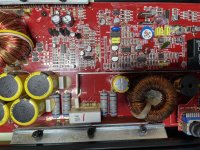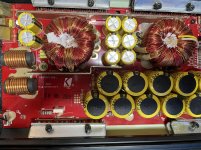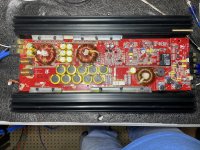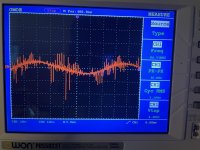While steadily increasing drive input it works well until it is drawing approx 50 amps on the bench ps and then it goes into protect (prior to output clip).
Although I do not believe I have maxxed out my bench supply, could amp be doing this due to limitations of the supply? Usually an amp just starts to output clip when it maxes out my supply, but not go into protect.
Am about to trace out the overcurrent circuit as I have no drawings.
Any help would be great.
Although I do not believe I have maxxed out my bench supply, could amp be doing this due to limitations of the supply? Usually an amp just starts to output clip when it maxes out my supply, but not go into protect.
Am about to trace out the overcurrent circuit as I have no drawings.
Any help would be great.
Hi peeby,
Once upon a time I designed amps for Kicker, but long before the ZX1500.1 came out. (in other words, I don't have a schematic.) This could be due to supply limitations. Peak current can be well in excess of average current. Perhaps you could try putting a hefty car battery in parallel with your 50 A supply.
This shutdown would be due not to overcurrent protection in the amplifier, but the undervoltage lockout protection at the battery input. Do you have an oscilloscope that you can monitor the battery voltage at the amplifier? If it drops below 10V, that may be a problem, and if it drops below 8V, that's a shutdown event.
Once upon a time I designed amps for Kicker, but long before the ZX1500.1 came out. (in other words, I don't have a schematic.) This could be due to supply limitations. Peak current can be well in excess of average current. Perhaps you could try putting a hefty car battery in parallel with your 50 A supply.
This shutdown would be due not to overcurrent protection in the amplifier, but the undervoltage lockout protection at the battery input. Do you have an oscilloscope that you can monitor the battery voltage at the amplifier? If it drops below 10V, that may be a problem, and if it drops below 8V, that's a shutdown event.
What is the size of your bench supply. If 50 amp this won't be enough. A car battery in parallel would work as Russell suggested.
If you still have issues post pics of board. I have schematics and can walk you through any repairs.
Hi Russell btw still fixing the occasional ZR! Truly a legacy line of Amps!
If you still have issues post pics of board. I have schematics and can walk you through any repairs.
Hi Russell btw still fixing the occasional ZR! Truly a legacy line of Amps!
Put a 12V truck battery in parallel with my bench supply.
Question - so when I first paralleled the battery and the PS the PS was charging the battery, so it saw the battery as a load. Could the PS be seeing the battery and the amp as a load?
Amp is still opening the relay before it clips.
Voltage at amp is well above 12v when amp relay opens.
Question - so when I first paralleled the battery and the PS the PS was charging the battery, so it saw the battery as a load. Could the PS be seeing the battery and the amp as a load?
Amp is still opening the relay before it clips.
Voltage at amp is well above 12v when amp relay opens.
The battery's charge was lower than the PS voltage. In that situation, the battery was a slight load.
You need to put a cutoff switch and a fuse in series with the battery for safety.
You need to put a cutoff switch and a fuse in series with the battery for safety.
So with it being a slight load, did it help increase or decrease the current available to the amp?
It depends on the supply voltage. If the supply voltage is very low (ie 10.5v), the battery won't do much. If the supply voltage is 13v or greater, a healthy battery will help greatly.
The files in the following folder show how much current a healthy, fully charged battery can deliver and the voltage that it's dragged down to at that current. Above 12.5v, the battery will contribute little or nothing to the supply voltage.
You'll need to view full size to see the lines clearly.
Index of /temp/battery test
The files in the following folder show how much current a healthy, fully charged battery can deliver and the voltage that it's dragged down to at that current. Above 12.5v, the battery will contribute little or nothing to the supply voltage.
You'll need to view full size to see the lines clearly.
Index of /temp/battery test
OK. Back to the amp.
It was brought to me because it was shutting down under high load.
I am driving into a 4 ohm load and even with the 12V battery/PS combo it is shutting down. Multimeter on the amp power terminals and a increasing input sine wave drive - it shuts off and there is 12.6V of power available. I tend to think it is shutting down - not by design.
It was brought to me because it was shutting down under high load.
I am driving into a 4 ohm load and even with the 12V battery/PS combo it is shutting down. Multimeter on the amp power terminals and a increasing input sine wave drive - it shuts off and there is 12.6V of power available. I tend to think it is shutting down - not by design.
12.6v when the amp shuts down? You'll need to monitor with the scope unless you're using a sine wave.
Is the battery healthy enough to easily start a car?
Is the battery healthy enough to easily start a car?
Battery is in great shape.
I am driving with a sine wave. Slowly increasing input to the amp. The amp is not to the point of clipping when it shuts down.
Voltage at power terminals on amp is 12.6V (measured with a multimeter) when it shuts down.
I am driving with a sine wave. Slowly increasing input to the amp. The amp is not to the point of clipping when it shuts down.
Voltage at power terminals on amp is 12.6V (measured with a multimeter) when it shuts down.
It sounds to me like there is something wrong with the undervoltage circuit, causing the threshold voltage to be too high. Maybe a bad resistor, cap, or solder joint. Something causing the signal to the UVLO pin of the power supply controller IC to be compromised.
That's just my suspicion. Seems like the amp is fine otherwise, from your description. I definitely think you need to look at the power supply input terminal with an oscilloscope, if available, and determine what the minimum voltage is there. You need to rule out dips in the 12V supply. Alternately, with no signal input, vary the 12V supply to lower voltages and determine at what battery voltage it shuts off.
Zbill can maybe help you with internal points to check.
That's just my suspicion. Seems like the amp is fine otherwise, from your description. I definitely think you need to look at the power supply input terminal with an oscilloscope, if available, and determine what the minimum voltage is there. You need to rule out dips in the 12V supply. Alternately, with no signal input, vary the 12V supply to lower voltages and determine at what battery voltage it shuts off.
Zbill can maybe help you with internal points to check.
If you would Peeby, post pics of board. One overall, then two more spitting the board with and without preamp and daughter board.
D7 will disable OCP and DC Protection. I will get into this more when I see the pics. The pics will help me determine the version you have on your bench,
D7 will disable OCP and DC Protection. I will get into this more when I see the pics. The pics will help me determine the version you have on your bench,
Can I ask a basic question? This amp seems to have a lot of noise, everywhere. Even on the ground.
What is the basic test for the rail filter caps.
Pic is of the negative rail. it is at -100v. I put the scope on AC so I could bring it up on 10V resolution. That sine wave follows the input sine wave to a degree.
What is the basic test for the rail filter caps.
Pic is of the negative rail. it is at -100v. I put the scope on AC so I could bring it up on 10V resolution. That sine wave follows the input sine wave to a degree.
Attachments
That noise looks bad, but it may just be the location of your probe ground. The audio side of the power supply is likely grounded separately from the 12 V side.
- Home
- General Interest
- Car Audio
- Kicker ZX1500.1 protects when driven hard



